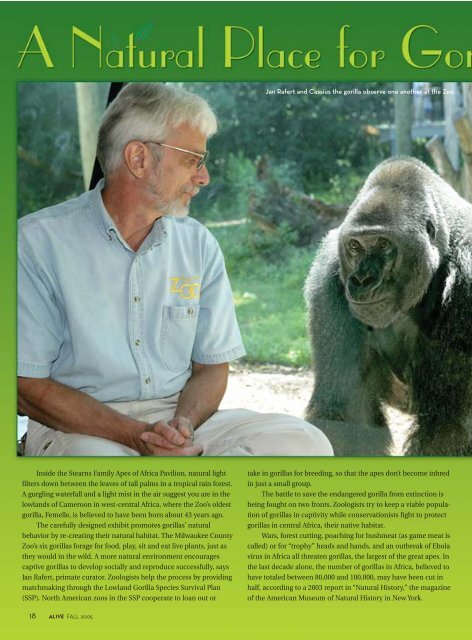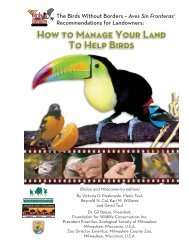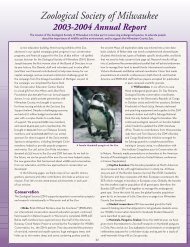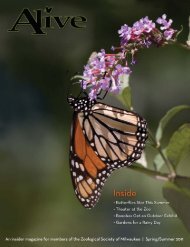AliveFall 2005 - Zoological Society of Milwaukee
AliveFall 2005 - Zoological Society of Milwaukee
AliveFall 2005 - Zoological Society of Milwaukee
You also want an ePaper? Increase the reach of your titles
YUMPU automatically turns print PDFs into web optimized ePapers that Google loves.
Inside the Stearns Family Apes <strong>of</strong> Africa Pavilion, natural light<br />
filters down between the leaves <strong>of</strong> tall palms in a tropical rain forest.<br />
A gurgling waterfall and a light mist in the air suggest you are in the<br />
lowlands <strong>of</strong> Cameroon in west-central Africa, where the Zoo’s oldest<br />
gorilla, Femelle, is believed to have been born about 43 years ago.<br />
The carefully designed exhibit promotes gorillas’ natural<br />
behavior by re-creating their natural habitat. The <strong>Milwaukee</strong> County<br />
Zoo’s six gorillas forage for food, play, sit and eat live plants, just as<br />
they would in the wild. A more natural environment encourages<br />
captive gorillas to develop socially and reproduce successfully, says<br />
Jan Rafert, primate curator. Zoologists help the process by providing<br />
matchmaking through the Lowland Gorilla Species Survival Plan<br />
(SSP). North American zoos in the SSP cooperate to loan out or<br />
18 ALIVE FALL <strong>2005</strong><br />
Jan Rafert and Cassius the gorilla observe one another at the Zoo.<br />
take in gorillas for breeding, so that the apes don’t become inbred<br />
in just a small group.<br />
The battle to save the endangered gorilla from extinction is<br />
being fought on two fronts. Zoologists try to keep a viable population<br />
<strong>of</strong> gorillas in captivity while conservationists fight to protect<br />
gorillas in central Africa, their native habitat.<br />
Wars, forest cutting, poaching for bushmeat (as game meat is<br />
called) or for “trophy” heads and hands, and an outbreak <strong>of</strong> Ebola<br />
virus in Africa all threaten gorillas, the largest <strong>of</strong> the great apes. In<br />
the last decade alone, the number <strong>of</strong> gorillas in Africa, believed to<br />
have totaled between 80,000 and 100,000, may have been cut in<br />
half, according to a 2003 report in “Natural History,” the magazine<br />
<strong>of</strong> the American Museum <strong>of</strong> Natural History in New York.













